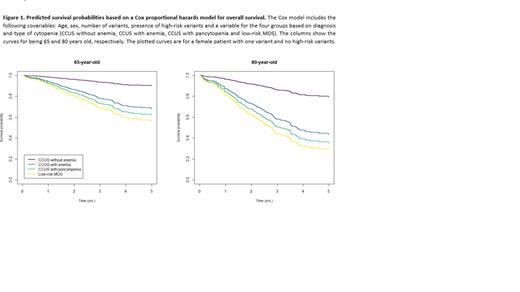Introduction
Clonal cytopenia of undetermined significance (CCUS) is a recently recognized hematological disorder characterized by the presence of one or more cytopenias, evidence of clonal hematopoiesis and not fulfilling the criteria for a myeloid neoplasm. In contrast to myelodysplastic syndromes (MDS) where 95% of the patients are anemic at time of diagnosis, that is only the case for around 60% of patients with CCUS (Weeks et al. Prediction of Risk for Myeloid Malignancy in Clonal Hematopoiesis. NEJM Evid. 2023). Furthermore, as recent studies on survival in CCUS primarily included younger patients (Weeks et al. NEJM Evid. 2023) or population-based cohorts not specifically referred for diagnostic work up of unexplained cytopenia (UC) (Rossi et al. Clinical relevance of clonal hematopoiesis in persons aged ≥80 years, Blood 2021) additional survival data on patients with CCUS are warranted. In this study, we investigated survival outcomes in patients with CCUS referred for primary work up of UC.
Methods
We included 241 patients with CCUS and compared them to 144 patients with low-risk MDS, defined as having less than 5% blasts in the bone marrow. Bone marrow biopsies and next-generation sequencing (NGS) were performed in all patients and cytogenetic analyses using G-band karyotyping was done in 362 (94%) of cases. For NGS, we used a gene panel with the most commonly mutated genes in MDS. The patients were included at 6 different institutions in Denmark from 2013 and onwards. A cut-point of 5 years follow-up was chosen for more robust survival data, and patients were censored at this time point if followed for more than 5 years. Patients with CCUS were stratified into 3 groups dependent on the type of cytopenia present at diagnosis. CCUS patients with pancytopenia (n = 35), and CCUS patients without pancytopenia were split based on whether they were anemic (n = 143) or not (n =63). We compared overall survival between the CCUS groups and low-risk MDS in a Cox proportional hazards model adjusted for age, sex, number of variants and presence of high-risk variants.
Results
Of the 241 CCUS patients, 178 (74%) were anemic (hemoglobin < 12 and 13 g/dL for women and men, respectively), while this was the case for 130 (90%) of the patients with MDS. A total of 772 variants were identified in the entire cohort with a median of 2 (IQR: 1-3) per patient for both CCUS and MDS patients. The overall survival at 5 years was 45% for low-risk MDS patients and 62% for CCUS patients. For CCUS patients without anemia, CCUS patients with anemia and CCUS patients with pancytopenia overall survival at 5 years was 85%, 52% and 55%, respectively (p < 0.0001). In the adjusted Cox proportional hazards model, we found a significantly superior overall survival for CCUS patients without anemia compared to those with anemia (HR: 0.28, 95%-CI: 0.13-0.58, p = 0.001) and pancytopenia (HR: 0.22, 95%-CI: 0.09-0.53, p = 0.001) and patients with low-risk MDS (HR: 0.18, 95%-CI: 0.09-0.38, p < 0.001). There was no significant survival difference between CCUS patients with pancytopenia and low-risk MDS patients (HR: 0.67, 95%-CI: 0.46-1.50, p = 0.5). Of the remaining variables, age was the strongest prognostic factor with hazard ratio increasing with a factor 1.05 (95%-CI: 1.03-1.07, p < 0.001) per year aged. Predicted survival probabilities for a 65-year-old and 80-year-old person demonstrate a substantial difference in overall survival across all 3 categories of CCUS (figure 1).
Discussion
Here we show that the presence of anemia impacts overall survival among CCUS patients. We observe that CCUS patients without anemia, representing 26% of CCUS patients in our cohort, have a superior overall survival compared to those with anemia, even with a comparable mutational profile. Our findings indicate that other factors than mutational signatures impact overall survival. Moreover, the prevalence of CCUS increases with age, and our findings demonstrate a considerable difference in survival between a 65-year-old and 80-year-old person diagnosed with CCUS. This raises the concern that prediction models can overestimate the survival rates if the elderly group of CCUS patients is not well represented in these models.
In conclusion, we show that age and hemoglobin levels are important factors in overall survival for CCUS patients, and that patients with CCUS without anemia have a superior overall survival and should be considered as a separate group within the CCUS category.
Disclosures
Grønbæk:Kirsten Grønbæk received research support from Janssen and is on the advisory board of Nanexa and GSK.: Consultancy, Research Funding. Hansen:Bristol Myers Squibb: Consultancy, Speakers Bureau.


This feature is available to Subscribers Only
Sign In or Create an Account Close Modal